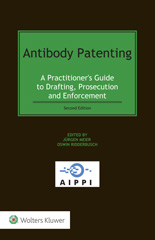2023 - Wolters Kluwer
E-book
Digital Version
Streaming only | NO download | NO Copy/paste | NO Printing
Antibody Patenting : A Practitioner's Guide to Drafting, Prosecution and Enforcement
672 p.
- Antibodies have revolutionized medicine and biotechnology, and have become indispensable tools in therapy, diagnostics, analytics, and research. Therapeutic antibodies, for example, have become firmly established in the ranks of blockbuster drugs, currently accounting for about half of the top 10 best-selling medicines. At the same time, a body of case law dealing specifically with the patentability of antibody-related inventions and the enforcement of antibody patents has emerged in major jurisdictions. The, at times, significant divergences between different jurisdictions have been compounded by recent decisions in the United States, which have severely curtailed the possibilities to obtain broad antibody patents. It is therefore essential to understand how antibody inventions are assessed in different jurisdictions in order to secure an optimal patent protection and to successfully enforce such patents.This book provides practitioners with a comprehensive resource elucidating all aspects of the patenting o
- f antibodies from initial drafting and prosecution to enforcement, using a country-by-country format. The updated and expanded Second Edition covers more than 30 of the most important IP jurisdictions worldwide - i.e., the European Patent Office, Belgium, Denmark, Finland, France, Germany, Hungary, Ireland, Italy, the Netherlands, Poland, Spain, Sweden, Switzerland, the United Kingdom, the United States of America, Canada, Mexico, the Andean Community (Bolivia, Colombia, Ecuador, and Peru), Argentina, Brazil, Chile, China, India, Israel, Japan, Singapore, South Korea, Taiwan, Australia, and New Zealand. The 49 contributors to this book, all distinguished experts in this field, provide clear and practice-oriented advice on a range of topics including: ⢠Which types of antibody inventions are patent-eligible?⢠Which types of functional and structural features are accepted for claiming antibodies?⢠What needs to be considered when defining antibodies in terms of their antigen, target affi
- nity,.
- binding specificity, epitope, competitive binding and other characteristics in relation to reference antibodies, as well as their effects on the target?⢠Which pitfalls must be avoided when defining amino acid sequences, chemical modifications or glycosylation patterns, and when relying on cell line deposits?⢠Which breadth of claims is accepted for antibody inventions, and what experimental support is required?⢠Which specific medical applications of antibodies can be claimed?⢠How is inventive step assessed in the specific case of antibody inventions?⢠What has to be considered when enforcing antibody patents, including in relation to biosimilars as well as the doctrine of equivalence?All chapters follow the same structure, which makes this book easily accessible and allows a direct comparison between different jurisdictions. Practitioners will find the much-needed tools and guidance to secure the best possible patent protection for antibody inventions in more than 30
- of the mo.
- st important jurisdictions worldwide.This book is the fifth volume in the AIPPI Law Series which has been established together with the International Association for the Protection of Intellectual Property (AIPPI), a non-affiliated, non-profit organization dedicated to improving and promoting the protection of intellectual property at both national and international levels. [Publisher's text].
- Special access authorizations may apply; please contact us for further information.
-
Information
ISBN: 9789403542164
SERIES
DISCIPLINES


